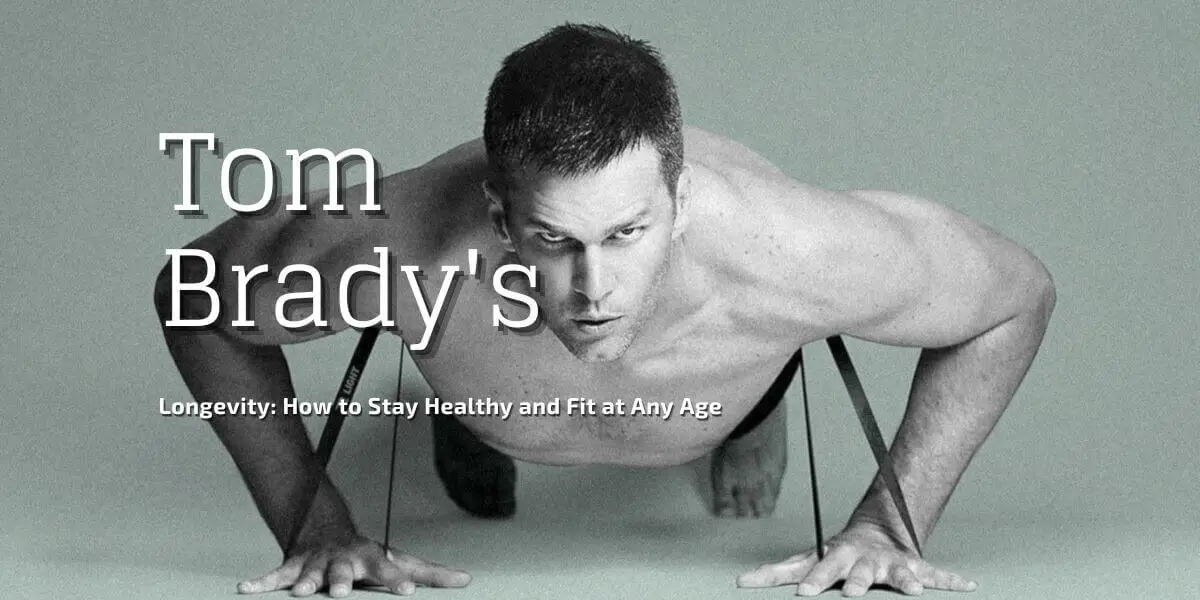Staying in the Game: Tom Brady’s Training Tips to Keep You Healthy and Fit for the Long Haul
Athletes who strive for greatness often have to train harder and smarter than their competitors. Tom Brady, a seven-time Super Bowl champion quarterback, is no exception. He has built his career on hard work, dedication, and an unwavering commitment to staying in peak physical condition.
In this article, we will explore some of the training tips that Tom Brady uses to keep himself healthy and fit for the long haul. We’ll look at how he approaches:
- Nutrition
- Exercise
- Recovery
- Mental preparation
All these elements are crucial to any athlete’s success. Whether you’re an aspiring athlete or simply looking to improve your overall health and fitness levels, there are lessons to be learned from one of the greatest players in NFL history.
The Importance Of Proper Nutrition
Proper nutrition is essential for individuals who aspire to maintain optimal health and fitness levels. Meal planning plays a crucial role in ensuring that athletes consume the necessary nutrients required by their bodies.
Nutrient timing is another critical component of proper nutrition, which involves consuming specific macronutrients at particular times throughout the day. Meal planning requires careful consideration of an individual’s dietary requirements, such as caloric intake, protein consumption, carbohydrate intake, and fat content.
A well-designed meal plan ensures that athletes meet these nutrient needs while also providing sufficient energy to sustain physical activity. Additionally, it helps prevent overeating or undereating, both of which could compromise athletic performance.
Nutrient timing refers to the practice of strategically ingesting macronutrients before and after exercise sessions. Pre-workout meals provide fuel for physical activity and help delay fatigue during training sessions. On the other hand, post-workout meals replenish glycogen stores and facilitate muscle recovery and growth.
Properly timed nutrient ingestion improves overall workout performance and reduces the risk of injury associated with inadequate fueling strategies.
Tailoring Your Exercise Routine To Your Needs
Customizing workouts to fit your individual needs is crucial for achieving long-term fitness goals. Your exercise routine should be tailored according to your current level of fitness, age, and health conditions.
For instance, older individuals may need more low-impact exercises such as swimming or cycling to avoid joint pain or injuries. Adapting to age is a vital aspect of customizing workouts. As we grow older, our bodies change in ways that can affect our physical abilities. It’s important to listen to your body and adjust the intensity of your workout accordingly.
Aging also comes with an increased risk of chronic diseases, so it’s essential to incorporate strength training and cardiovascular exercises into your routine for overall health benefits.
Moreover, customizing your workout plan can help prevent boredom and keep you motivated towards reaching your fitness goals. Incorporating different types of exercises such as yoga or weight lifting can add variety to your routine while challenging different muscle groups.
Consulting with a personal trainer or healthcare professional can help create a customized exercise plan tailored specifically to your needs and preferences. A personalized approach will not only improve physical performance but also promote mental well-being by keeping you engaged and motivated throughout the process.

Source- Google
The Role Of Recovery In Training
Tailoring your exercise routine to your needs is vital for achieving fitness goals without risking injury. However, it’s not just about what you do during your workout that counts: recovery plays a crucial role in training too. Without proper rest and rejuvenation between workouts, our bodies can become fatigued, making us more prone to injury.
One effective method of promoting active recovery is foam rolling. This technique involves using a cylindrical foam roller to massage sore or tight muscles, breaking down adhesions and increasing blood flow. By incorporating foam rolling into your post-workout routine, you may be able to reduce muscle tension and improve flexibility, enabling better overall performance.
Apart from active recovery techniques like foam rolling, sleep hygiene and stretching techniques are also essential components of an effective recovery plan. Sleep deprivation can lead to increased stress levels and decreased cognitive function, both of which can interfere with athletic performance.
Similarly, stretching helps prevent muscle injuries by improving range of motion and reducing stiffness. Four items that can aid in post-workout recovery include:
- Massage balls for targeted deep tissue work
- Aromatherapy oils such as lavender or peppermint for relaxation
- Cold therapy products like ice packs or cold baths for reducing inflammation
- Compression wear such as leggings or sleeves for improved circulation

Source – Google
Mental Preparation For Peak Performance
Apart from physical training, mental preparation is also crucial in achieving peak performance. Visualization techniques and mindfulness practices are two effective strategies utilized by athletes to enhance their focus, clarity of mind, and overall well-being.
Visualization techniques involve creating a detailed image or scenario in one’s mind of the desired outcome or goal. By visualizing success repeatedly, an athlete can train his/her brain to become more familiar with the situation and increase confidence levels.
Studies have shown that visualization can improve muscle memory as it activates similar neural pathways as actual physical practice. Mindfulness practices such as meditation and deep breathing exercises help individuals manage stress levels and reduce anxiety before competitions.
The ability to stay present and focused on the task at hand without distractions increases concentration levels needed for optimal performance. Mindful practices promote emotional regulation which aids in preventing burnout and exhaustion over time.
Incorporating mental preparation into one’s daily routine can significantly impact an individual’s athletic abilities and overall health. Applying visualization techniques and mindfulness practices along with physical training helps create a holistic approach towards maximizing one’s potential for long-term success.
Balancing Work And Rest
Mental preparation is undoubtedly crucial to achieving peak performance, but it’s only one piece of the puzzle in maintaining an athlete’s longevity. Finding time for rest and recovery is just as important as training itself.
Tom Brady understands this balance well, which has contributed to his success both on and off the field. Finding time for adequate rest can be challenging when balancing a hectic schedule.
Prioritizing rest means setting boundaries around work schedules and creating space for relaxation or other stress-reducing activities such as meditation, yoga, or massage therapy.
When considering the importance of finding time for rest and prioritizing it, there are several factors to consider. Sleep quality and quantity play a significant role in recovery rates from physical exertion or injury.
Nutrition also impacts how well athletes recover after intense training sessions or competitions.

Source- Google
Staying Motivated For The Long Haul
Sustaining motivation for an extended period is a challenge that many athletes face. However, it’s crucial to stay committed and consistent with your training routine if you want to achieve long-term fitness goals.
It’s not easy to maintain the same level of enthusiasm every day, but there are ways to overcome this obstacle. One way to cultivate consistency in your workouts is by setting achievable goals that align with your overall objectives. Break down larger targets into smaller milestones and celebrate each success along the way. This approach will help keep you motivated and focused on what matters most – progress towards achieving your ultimate goal.
Another way to stay energized during prolonged periods of exercise is by overcoming plateaus effectively. Plateaus can be frustrating because they often seem like roadblocks that prevent further progress.
Instead of feeling discouraged or giving up entirely, try modifying your workout regimen or introducing new exercises to challenge yourself creatively. Doing so might reignite your passion for working out while also helping you break through any physical barriers holding back progress.
Incorporating Functional Training
Functional training has become increasingly popular in recent years, and for good reason. This type of exercise focuses on improving movement patterns that are used in everyday life, making it an essential component of injury prevention.
Rather than isolating individual muscle groups, functional training emphasizes the use of multiple muscle groups working together to perform movements that mimic daily activities.
One key aspect of functional training is core strength. The muscles in your core provide stability and support for your entire body during movement, so a strong core is crucial for preventing injuries. Functional exercises like planks and bird dogs can help improve core strength while also incorporating other muscle groups.
Mobility training is another important component of functional training. Mobility refers to the ability to move joints through their full range of motion with control and stability. By performing exercises that emphasize mobility, you can improve flexibility, reduce stiffness and soreness, and prevent injuries caused by limited range of motion.
Incorporating functional training into your workout routine can be highly beneficial for injury prevention and overall fitness. Focusing on functional movement patterns, building core strength, and emphasizing mobility will not only keep you healthy but also enhance your performance in all areas of life.
Embracing A Growth Mindset
Incorporating functional training into your workout routine is a great way to improve your overall fitness and develop the strength and flexibility necessary for staying in the game. However, even with proper training, there will always be obstacles that challenge you along the way.
Developing resilience is key to overcoming these obstacles and achieving your long-term goals. Resilience can be defined as the ability to bounce back from setbacks or adversity. It involves having a growth mindset and being open to learning from failures and mistakes rather than giving up when faced with challenges.
To develop resilience, it’s important to embrace discomfort and push yourself outside of your comfort zone on a regular basis. Overcoming obstacles also requires mental toughness. This means maintaining focus on your goals even when things get tough, practicing positive self-talk, and staying motivated despite setbacks.
Frequently Asked Questions
What Is Tom Brady’s Daily Routine Like?
Tom Brady, the legendary quarterback of the New England Patriots, has a highly regimented daily routine that focuses on sleep and nutrition, workout and recovery.
His schedule typically begins with waking up at 5:30 am followed by meditation and stretching exercises. He then consumes a protein-rich breakfast consisting of eggs, avocado, and meat before heading to his team’s facility for practice sessions.
After practice, he engages in strength training exercises combined with flexibility routines such as yoga or Pilates. Post-workout meals consist of lean meats and vegetables while avoiding processed sugars and carbohydrates.
To aid in his recovery process, he regularly indulges in deep-tissue massages, cryotherapy treatments, and sauna therapy sessions.
How Does Tom Brady Manage To Balance His Family Life With His Football Career?
Balancing priorities and managing time are critical skills for anyone, but they become even more important when balancing family life with a demanding career. Tom Brady is no exception to this struggle, as he manages to excel both on the football field and at home with his wife and children.
To balance these priorities successfully, Brady employs several time management strategies such as prioritizing tasks, delegating responsibilities, setting boundaries around work hours, and ensuring quality time with family members.
What Are Some Of Tom Brady’s Favorite Healthy Recipes?
Tom Brady, a well-known American football quarterback, is known for his strict diet and healthy lifestyle.
Some of his favorite healthy recipes include Acai bowls and Avocado ice cream. The former typically consists of blended Acai berries topped with fruits, nuts, or granola while the latter involves blending avocados with coconut milk and honey to create a creamy dessert.
These dishes are packed with nutrients such as antioxidants and healthy fats that can aid in maintaining overall health. Tom’s emphasis on nutritious food choices serves as an inspiration to many individuals looking to maintain a balanced diet.
How Does Tom Brady Deal With Injuries And Setbacks During Training?
Recovery methods and injury prevention strategies are crucial for athletes to maintain their physical health during training.
One approach employed by many is the use of ice baths, which can help reduce inflammation and muscle soreness after a strenuous workout. In addition, stretching before and after exercise can decrease the likelihood of injuries such as strains or sprains.
For more serious injuries, rehabilitation programs may be necessary to fully recover and prevent future setbacks. Proper nutrition and hydration also play a significant role in recovery, providing the body with essential nutrients needed to repair muscles and tissues.
What Advice Does Tom Brady Have For Aspiring Athletes Who Are Just Starting Out?
For aspiring athletes who are just starting out, it is essential to understand the importance of consistency and building a strong foundation. Consistency in training can help develop discipline and improve overall performance, while establishing a proper foundation sets the groundwork for long-term success.
Tom Brady advises young athletes to focus on mastering the basics before moving on to more advanced techniques or workouts. This includes developing good posture, practicing proper breathing techniques, and maintaining a balanced diet.
Conclusion
Tom Brady is a professional American football player who has won numerous championships and accolades throughout his career. His success can be attributed not only to his skill on the field, but also to his dedication to maintaining a healthy lifestyle both on and off the field.
Through careful management of his daily routine, including regular exercise, proper nutrition, and restful sleep, Brady has been able to achieve longevity in his career. In addition to physical health, Brady emphasizes the importance of mental well-being as an athlete.
He encourages aspiring athletes to focus on their goals and remain committed even when faced with setbacks or challenges. By adopting these habits and following Brady’s advice for staying fit and focused, anyone can work towards achieving their own personal bests in athletics and beyond.




